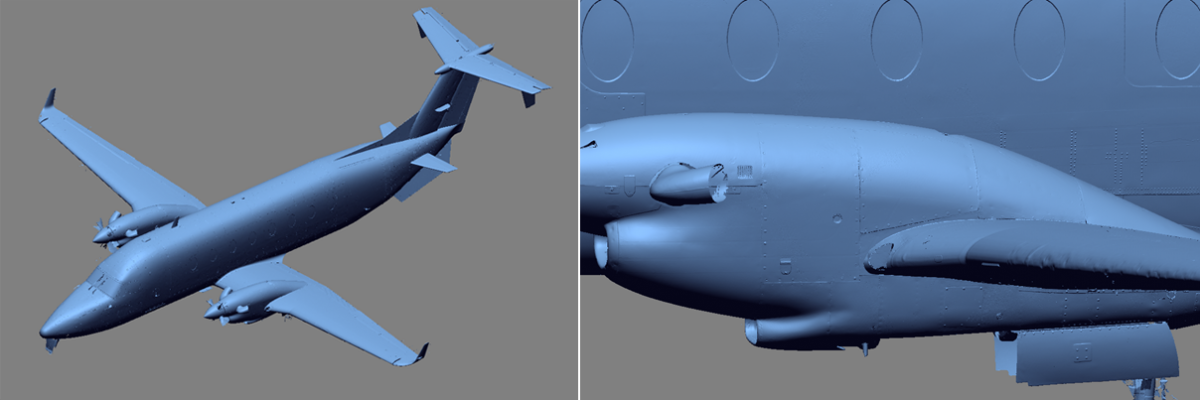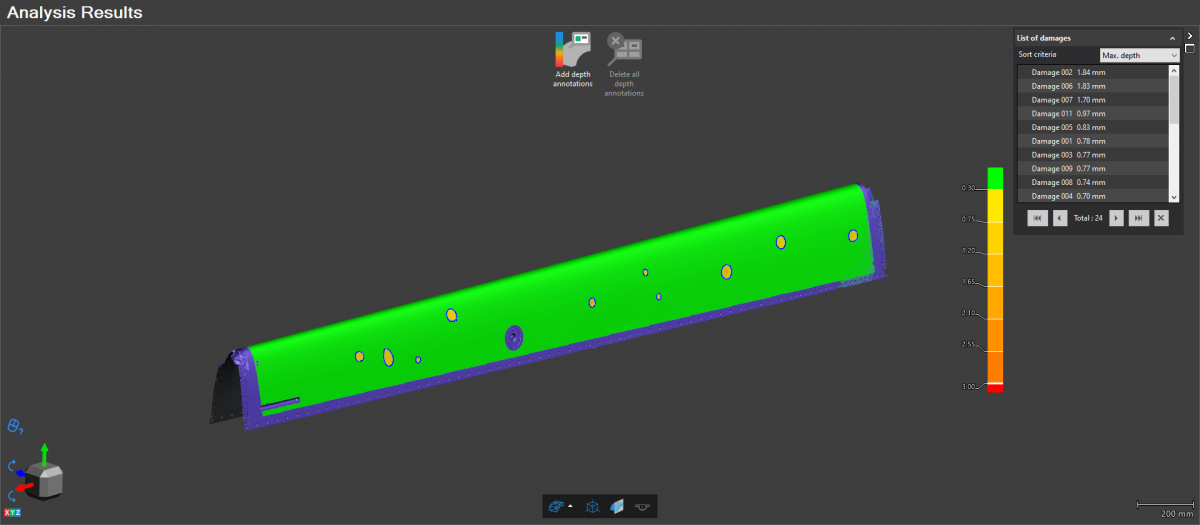Exit this form
Are you sure you want to quit this form?
Hailstorms are among the most unpredictable and sudden of all weather patterns, capable of causing extensive damage to flying airplanes. In some cases, the fuselage can be partially or entirely damaged, compromising the aircraft’s lift. The grounding of planes is, therefore, mandatory to proceed with assessment and maintenance work.

Beechcraft 1900D that had flown through a hailstorm with dents on the leading edge of the aircraft
When performed manually, hail damage assessment can take between four and five hours per square meter. Considering the size of an entire plane, the manual inspection work can last several weeks, during which time, the airplane is grounded and the airline loses money. Due to technological advances in modern inspection techniques, there is no longer a need to carry out this long and tedious manual work. Cutting-edge hail damage assessment is the key to ensuring that damaged airplanes are immobilized for as short a time as possible.
Locating a dent's beginning is not always obvious, but this information is crucial to sizing it correctly. With manual measurements, subjectivity can often influence results, causing variations that are more or less critical, depending on the technician. Considering the serious consequences of hailstorms, an algorithm should always calculate dent contours and dimensions. This way, the results will always be the same, regardless of the technicians' skills or techniques.
As prescribed by the authorities on the matter, any defect to an aircraft must be rigorously documented. Nevertheless, the task can quickly become tedious and complex when the plane has recorded a significant number of defects. How can one identify and differentiate each blemish when the aircraft looks like a golf ball? The task becomes simple and easy when you have access to a large amount of digitized data and automatic reports, as they enable much easier consultation and further analysis. This is where 3D scanning comes into play.

Complete mesh and exact digital replicate of the damaged aircraft scanned with the MetraSCAN 3D
User-independence: With 3D scanning technology, the results are not affected by how the measurements are taken and the skill level of the technicians. Service companies are certain to obtain the same unique scan regardless of the technician’s experience, allowing them to proceed with data acquisition and analysis without extensive intervention.
Traceability: With the integrity assessment power offered by 3D scanning, aerospace engineering teams can acquire large amounts of high-accuracy data to conduct in-depth assessments of hail damage. As the results are traceable, they can be used to document, follow, and compare the evolution of damage over time.
Repeatability: With 3D scanning, MRO specialists can detect and measure the length, width, and depth of each dent on a given service plane. With the guidance of the aerospace module’s powerful algorithms, they can analyze the dent’s position and defect level according to configurable criteria. This way, their analyses are always objective, leading to better conclusions and decision-making.
Compliance with Boeing and Airbus: Because the aerospace industry is highly regulated, MRO companies have no choice but to rely on documentation that OEMs have already established and validated. Creaform’s technology complies with Boeing’s service letter and is part of Airbus’s official service equipment catalogue, meaning that the most influential names in aerospace endorse it as a solution for hail damage assessment.
VXintegrity’s Aerospace Module equipped with the HandySCAN 3D|BLACK Series is the only technique available on the market that offers traceable, repeatable, and human-independent results that eliminate measurement variations and ambiguity in result interpretation.
The combined effect of 3D scanning and VXintegrity shortens the time required to assess hail damages and generate final reports, providing plane owners with comprehensive data on any dent that requires further analysis.

Dents on the leading edge of the aircraft used for analysis and reporting

Rapid3D, a supplier of 3D NDT solutions in western Canada, was called upon a rare and extreme damage case of a Beechcraft 1900D that had flown through a hailstorm.
The NDT integrity solution provider was asked to do a full hail damage assessment. The hail damage on the aircraft was so extensive because it covered almost all surfaces of the aircraft. “Doing a job of this magnitude manually would have taken an incredible amount of time and would have been very difficult”, concludes Ira Laughy, President at Rapid3D, “the whole surface of the aircraft was damaged.”
Using two MetraSCAN 3D, the team needed 32 hours (or 4 days) to scan the entire aircraft. Once they had acquired the scan data, the engineers utilized VXintegrity’s aerospace module to do a full analysis of all of the dents on 33 panels.
“Our customer had very specific requirements on how he wanted the damage measured and referenced,” adds Ira Laughy, “the aerospace module had all of the tools available to make this happen.” Because of the magnitude of the damage and the size of the aircraft, the process of doing the panel-by-panel analysis and delivering the 33-panel reports took another 65 hours.
In the end, the customer was delighted with the results, and the feedback from their insurance company was positive. It gave them an enhanced level of information to make an informed decision on the aircraft in a fraction of the amount of time. Measuring and referencing all of the dents manually would have simply been impossible to do.